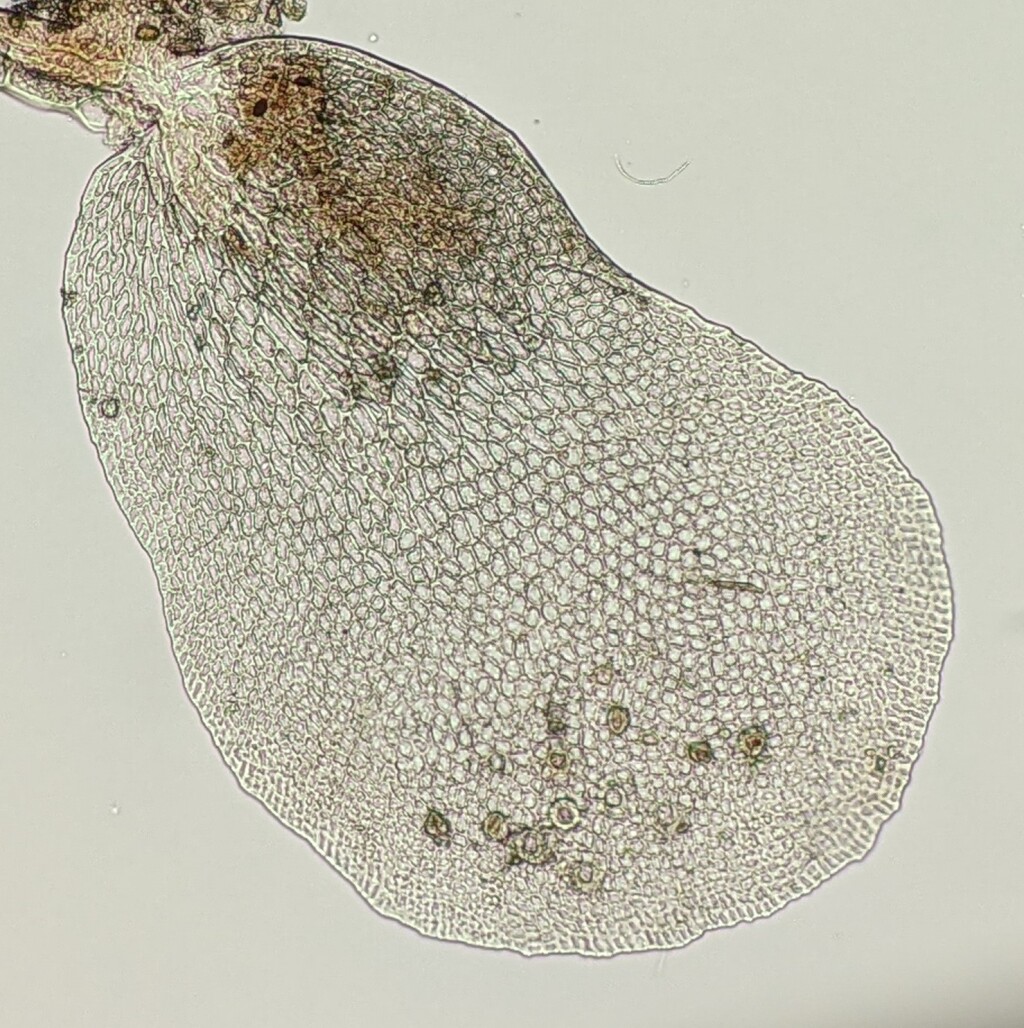Cololejeunea
Epiphytic (not in Victoria), epiphyllous or lithophytic (not in Victoria), monoicous or dioicous (not in Victoria). Asexual reproduction by discoid gemmae produced from lateral leaf lobe or adaxial thallus (not in Victoria) surface. Stems simple or sparsely irregularly branching and producing leaves, rarely a unistratose pinnate to bipinnate thallus with densely ciliate margins and leafy reproductive branches (not in Victoria); vegetative branches emerging from main stem near and ventral to an unmodified lateral leaf, and with a lobed and foliose collar at base, or rarely without a collar at base (not in Victoria). Lateral leaves imbricate to distant (not in Victoria), spreading and adhering to substrate, narrowly attached to stem; lobe narrowly lanceolate (not in Victoria) to broadly ovate (not in Victoria), elliptic (not in Victoria), or obovate, dentate (not in Victoria) to entire, often with a border of hyaline cells (not in Victoria), with acute (not in Victoria) or rounded apex, sometimes with a vitta (not in Victoria); lobule reduced to an elongated tooth (not in Victoria), vestigial and few celled (not in Victoria), or well-developed, quadrate, oblong, ovate, elliptic or triangular (not in Victoria), inflated, fused along basal margin to lobe forming a straight to arching keel, ending in sinus or continuous with margin of adjoining lobe (not in Victoria), free along apical margin and with 1–3 marginal teeth toward apex, sometimes with a filiform or linear multicellular stylus at base (not in Victoria); tooth furthest from stem single celled or multicellular; hyaline papilla at base of tooth furthest from stem on inner surface of lobule or on lobule margin next to tooth furthest from stem on side towards stem; cells quadrate to rectangular or hexagonal, smooth or papillose (not in Victoria), thin-walled, with small or large (not in Victoria) trigones or rarely without trigones (not in Victoria), with intermediate thickenings, with 1–20 granular or segmented ellipsoid to ovoid oil bodies, ocelli sometimes present (not in Victoria). Underleaves absent, or rarely present (not in Victoria), one for each lateral leaf, unlobed, ovate to lanceolate and serrulate to dentate. Perianth obovoid, 4–5-keeled, sometimes with spinose cellular projections (not in Victoria), with or rarely without (not in Victoria) a beak at apex.
Four hundred and six species shared between temperate to tropical regions throughout the world (Söderström et al. 2016); one species, C. laevigata (Mitten) Tilden, in Victoria.
Cololejeunea and the previously included Myriocoleopsis, are distinct among the Victorian Lejeuneaceae in lacking underleaves. In this respect they resemble Radulaceae, however, their placement in Lejeuneaceae and their close relationship to Colura and Diplasiolejeunea (Wilson et al. 2007; Yu et al. 2013) is confirmed by the production of a tuft of rhizoids for each lateral leaf on the stem, in the position where an underleaf would be expected. Colura and Diplasiolejeunea are distinct among the Victorian Lejeuneaceae for having an underleaf for each lateral leaf. Rhizoids when produced are produced at the base of the underleaves, which results in a tuft of rhizoids for each lateral leaf as is observed in Cololejeunea and Myriocoleopsis. In contrast, Radulaceae produce rhizoids from the lobule.
A group of three species from Malesia and southeast Asia previously recognised in the segregate genus Chondriolejeunea, but placed in the Cololejeunea DNA lineage (Yu et al. 2013) bear structures on the abaxial stem that have been variously interpreted. Kis & Pocs (2001) interpreted these structures as underleaves due to their position on the stem and the production of rhizoid initials at their base. However, in many species of Cololejeunea the stylus appendage is well developed, approaches the appearance of these structures and can be similar in form to well-developed styli that are often present in Frullania species. The morphology of these structures more closely resembles a well-developed stylus than underleaves but are positioned where an underleaf would be expected rather than at the base of the leaf attachment where styli are located in other Cololejeunea. If these structures are indeed equivalent to styli rather than underleaves, Cololejeunea would be defined by the absence of underleaves.
Kis, G. & Pócs, T. (2001). What is Chondriolejeunea? Cryptogamie Bryologie 22: 237–246.
Yu, Y., Pócs, T., Schäfer-Verwimp, A., Heinrichs, J., Zhu, R.-L. & Schneider, H. (2013). Evidence for rampant homoplasy in the phylogeny of the epiphyllous liverwort genus Cololejeunea. Systematic Botany 38: 553–563.
Wilson, R., Gradstein, S.R., Schneider, H. & Heinrichs, J. (2007). Unravelling the phylogeny of Lejeuneaceae (Jungermanniopsida): Evidence for four main lineages. Molecular Phylogenetics and Evolution 43: 270–282.
Söderström, L., Hagborg, A., von Konrat, M., Bartholomew-Began, S., Bell, D., Briscoe, L., Brown, E., Cargill, D.C., Costa, D.P., Crandall-Stotler, B.J., Cooper, E.D., Dauphin, G., Engel, J.J., Feldberg, K., Glenny, D., Gradstein, S.R., He, X., Heinrichs, J., Hentschel, J., Ilkiu-Borges, A.L., Katagiri, T., Konstantinova, N.A., Larraín, J., Long, D.G., Nebel, M., Pócs, T., Puche, F., Reiner-Drehwald, E., Renner, M.A.M., Sass-Gyarmati, A., Schäfer-Verwimp, A., Moragues, J.S., Stotler, R.E., Sukkharak, P., Thiers, B.M., Uribe, J., Váňa, J., Villarreal, J.C., Wigginton, M., Zhang, L. & Zhu, R. (2016). World checklist of hornworts and liverworts. Phytokeys 59: 1–828.
 Spinning
Spinning